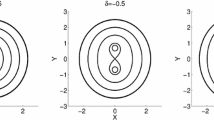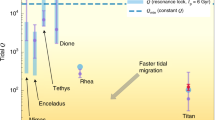Abstract
The Galilean satellites of Jupiter are called Io, Europa, Ganymede and Callisto. The first three moons are found in the so-called Laplace resonance, which means that their orbits are locked in a \(2:1\) resonant chain. Dissipative tidal effects play a fundamental role, especially when considered on long timescales. The main objective of this work is the study of the persistence of the resonance along the evolution of the system when considering the tidal interaction between Jupiter and Io. To constrain the computational cost of the task, we enhance this dissipative effect by means of a multiplying factor. We develop a simplified model to study the propagation of the tidal effects from Io to the other moons, resulting in the outward migration of the satellites. We provide an analytical description of the phenomenon, as well as the behaviour of the semi-major axis of Io as a function of the figure of merit. We also consider the interaction of the inner trio with Callisto, using a more elaborated Hamiltonian model allowing us to study the long-term evolution of the system along few gigayears. We conclude by studying the possibility of the trapping into resonance of Callisto depending on its initial conditions.












Similar content being viewed by others
Notes
The mean longitude is defined as \(\lambda_{k}=\varpi_{k}+M_{k}\), \(\varpi_{k}\) being the longitude of the perijove and \(M_{k}\) the mean anomaly of the \(k\)th satellite.
The radius of Jupiter is set equal to \(71492\) km.
The superscripts denote the order of magnitudes: for example, \(\Lambda^{(0)}\) is bigger than the \(X_{k}^{(1)}\) which are bigger than \(\Lambda^{(2)}\).
We have changed the notation used up to now in order to have a clearer view of the dynamics in terms of the Poincaré variables introduced below: the price to pay is that \(q_{3},q_{4}\) are not the best choice to compare with observations and this is the reason to consider also \(q_{3}^{0},q_{4}^{0}\), which are more familiar.
It should be stressed that the librations around \(\frac{\pi}{2}\) and \(\frac{3\pi}{2}\) appearing in Fig. 8 are an artefact due to the pumping factor \(\alpha\) enhancing the tidal interaction.
The case in which only the angle \(\mu\) librates never occurs.
References
Ferraz-Mello, S., Dynamics of the Galilean Satellites: An Introductory Treatise, Math. Dynam. As-tronom. Ser., vol. 1, São Paulo: Instituto Astronõmico e Geofisico, Universidade de São Paulo, 1979.
Henrard, J., Libration of Laplace’s Argument in the Galilean Satellites Theory, Celestial Mech., 1984, vol. 34, pp. 255–262.
Malhotra, R., Tidal Origin of the Laplace Resonance and the Resurfacing of Ganymede, Icarus, 1991, vol. 94, no. 2, pp. 399–412.
Celletti, A., Paita, F., and Pucacco, G., The Dynamics of the de Sitter Resonance, Celest. Mech. Dyn. Astron., 2018, vol. 130, no. 2, Paper No. 15, 15 pp.
Papaloizou, J. C. B., The Orbital Evolution of Resonant Chains of Exoplanets Incorporating Circularisation Produced by Tidal Interaction with the Central Star with Application to the HD 158259 and EPIC 245950175 Systems, Celest. Mech. Dyn. Astron., 2021, vol. 133, no. 30, Paper No. 30, 27 pp.
Yoder, C. F. and Peale, S. J, The Tides of Io, Icarus, 1981, vol. 47, no. 1, pp. 1–35.
Henrard, J., Orbital Evolution of the Galilean Satellites: Capture into Resonance, Icarus, 1983, vol. 53, no. 1, pp. 55–67.
Showman, A. P. and Malhotra, R., Tidal Evolution into the Laplace Resonance and the Resurfacing of Ganymede, Icarus, 1997, vol. 127, no. 1, pp. 93–111.
Lainey, V., Arlot, J.-E., Karatekin, Ö., and Van Hoolst, T., Strong Tidal Dissipation in Io and Jupiter from Astrometric Observations, Nature, 2009, vol. 459, no. 7249, pp. 957–959.
Couturier, J., Robutel, P., and Correia, A. C. M., An Analytical Model for Tidal Evolution in Co-Orbital Systems: 1. Application to Exoplanets, Celest. Mech. Dyn. Astron., 2021, vol. 133, no. 8, Paper No. 37, 30 pp.
Lari, G., Saillenfest, M., and Fenucci, M., Long-Term Evolution of the Galilean Satellites: The Capture of Callisto into Resonance, Astron. Astrophys., 2020, vol. 639, A40, 20 pp.
JUICE Definition Study Report (Red Book): Exploring the Emergence of Habitable Worlds around Gas Giants, https://sci.esa.int/documents/33960/35865/1567260128466 (2014).
Lieske, J. H., Galilean Satellite Evolution: Observational Evidence for Secular Changes in Mean Motions, Astron. Astrophys., 1987, vol. 176, pp. 146–158.
Paita, F., Celletti, A., and Pucacco, G., Element History of the Laplace Resonance: A Dynamical Approach, Astron. Astrophys., 2018, vol. 617, A35, 12 pp.
Celletti, A., Paita, F., and Pucacco, G., The Dynamics of Laplace-Like Resonances, Chaos, 2019, vol. 29, no. 3, 033111, 14 pp.
Celletti, A., Karampotsiou, E., Lhotka, C., Pucacco, G., and Volpi, M., Laplace-Like Resonances with Tidal Effects, Astron. Astrophys., 2021, vol. 655, A94, 16 pp.
Murray, C. D. and Dermott, S. F., Solar System Dynamics, Cambridge: Cambridge Univ. Press, 2000.
de Sitter, W., Jupiter’s Galilean Satellites (George Darwin Lecture), Mon. Not. R. Astron. Soc., 1931, vol. 91, no. 7, pp. 706–738.
Boué, G. and Efroimsky, M., Tidal Evolution of the Keplerian Elements, Celestial Mech. Dynam. Astronom., 2019, vol. 131, no. 7, Paper No. 30, 46 pp.
Goldreich, G. and Peale, S, Spin-Orbit Coupling in the Solar System, Astron. J., 1966, vol. 71, pp. 425–438.
Neishtadt, A. I., Averaging and Passage through Resonance, in Proc. Internat. Cong. of Mathematicians (Kyoto, Japan, Aug 1990), Tokyo: Springer, 1991, pp. 1271–1283.
Lainey, V., Quantification of Tidal Parameters from Solar System Data, Celest. Mech. Dyn. Astron., 2016, vol. 126, no. 1–3, pp. 145–156.
Pucacco, G., Normal Forms for the Laplace Resonance, Celest. Mech. Dyn. Astron., 2021, vol. 133, no. 3, Art. 11, 30 pp.
Laskar, J., Large Scale Chaos and the Spacing of the Inner Planets, Astron. Astrophys., 1997, vol. 317, L75–L78.
Gröbner, W. and Knapp, H., Contributions to the Method of Lie-Series, Mannheim: Bibliographisches Institut, 1967.
Giorgilli, A., Notes on Hamiltonian Systems, Cambridge: Cambridge Univ. Press, 2022.
Ferraz-Mello, S., Canonical Perturbation Theories: Degenerate Systems and Resonance, New York: Springer, 2007.
Batygin, K. and Morbidelli, A., Dissipative Divergence of Resonant Orbits, Astron. J., 2013, vol. 145, no. 1, Art. 1, 10 pp.
Pichierri, G., Batygin, K., and Morbidelli, A., The Role of Dissipative Evolution for Three-Planet, Near-Resonant Extrasolar Systems, Astron. Astrophys., 2019, vol. 625, A7, 14 pp.
ACKNOWLEDGMENTS
We acknowledge constant support and advice from S. Ferraz-Mello.
Funding
A. C., C. L. and G. P. acknowledge EU-ITN Stardust-R. A. C. (partially) and C. L. acknowledge the MIUR Excellence Department Project awarded to the Department of Mathematics, University of Rome Tor Vergata, CUP E83C18000100006. A. C. (partially), C. L. and G. P. acknowledge MIUR-PRIN 20178CJA2B “New Frontiers of Celestial Mechanics: Theory and Applications”, ASI Contract no. 2018-25-HH.0 (Scientific Activities for JUICE, C/D phase). C. L., G. P. and M. V. acknowledge the GNFM/INdAM. E. K. and M. V. acknowledge the ASI Contract no. 2018-25-HH.0 (Scientific Activities for JUICE, C/D phase). The research of E.K. was mainly done during her stay at the Dept. of Mathematics, University of Rome Tor Vergata during the years 2019-2021. G. P. is partially supported by INFN (Sezione di Roma II).
Author information
Authors and Affiliations
Corresponding author
Ethics declarations
The authors declare that they have no conflicts of interest.
Additional information
To the memory of Alexey Borisov
MSC2010
70F10, 70F15
APPENDIX. TIDAL CONTRIBUTION IN THE DELAUNAY VARIABLES
In this appendix we detail the computations of Eqs. (3.23) described in Section 3. Our goal is to transform the equations of the secular contribution due to the tidal effects acting on Io provided by [3]
Similarly, we have
Rights and permissions
About this article
Cite this article
Celletti, A., Karampotsiou, E., Lhotka, C. et al. The Role of Tidal Forces in the Long-term Evolution of the Galilean System. Regul. Chaot. Dyn. 27, 381–408 (2022). https://doi.org/10.1134/S1560354722040013
Received:
Revised:
Accepted:
Published:
Issue Date:
DOI: https://doi.org/10.1134/S1560354722040013




